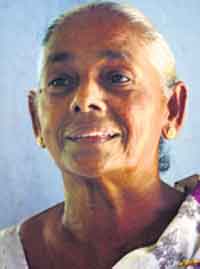|
|
||||
Healer of the dreaded snake-bite By Dhananjani Silva In most rural areas, the Sarpa Vedarala has his place as the saviour of those unfortunate victims of snake-bite. Likewise, in Parakaduwa Namaldeniya, is a well-known indigenous physician, who has saved the lives of countless people bitten by poisonous reptiles. Yasawathie Illnadarage, commonly known as ‘Weda Nanda’ has carved a niche in the village of Parakaduwa as an expert in treating snake-bite. The seventh generation in a long line of such indigenous physicians, 68-year-old Yasawathie’s methods are simple and natural. “I use the medicine I collect from the district,” she says, adding that she has an intimate knowledge of herbs and plants, and knows the art of not just preparing the medicine, but also the manner of collecting the herbs.
“You cannot just walk into the jungle, and collect herbs as you please. There are ways and means by which you get herbs. Even minute details, such as how the trees are positioned, the direction in which the roots spread need to be taken into consideration. At times you may even need to perform certain rituals,” Yasawathie explains. Yasawathie says it was her father’s influence as a snake-bite physician that made her set her heart on this vocation. “There were three children in my family, but more than everyone else, I showed a keen interest in the subject. I used to watch how my father treated the patients, and help him when I was a child. I would listen eagerly, when he was reading the medical books out loud. That is how I learnt everything,” she says, adding that she started treating patients on her own in her mid-30s, after the death of her father. According to Yasawathie, snake bite is a common occurrence in the Parakaduwa area. Most of the time, her patients are bitten by venomous snakes such as the Mapila (Cat-snake), Karawala (Krait), Thith-polonga (Russell's viper) and Kunakatuwa (Hump-nosed viper). “But there is hardly a day when I don’t get a patient even from faraway palaces, such as Anuradhapura, Polonnaruwa and Dambulla. Sometimes I give them accommodation, when they come from far away for treatment. Often when the victim is brought here, he or she may be unconscious for a couple of hours. Though immediate treatment is given to get the poison out of the system, I want to see progress in the patient’s condition within one hour. But the treatment has to be continued for at least ten days until the patient is fully recovered,” she explained. Yasawathie was the first in the Ratnapura District to get through the recent examination conducted by the Kuruwita Sanrakshana Sabahawa, in collaboration with the Health and Indigenous Ministry, and now has official recognition as a physician. She was also recently felicitated at Bodimaluwa Sri Nagabodhi Viharaya, Eheliyagoda for the service she has rendered. Nevertheless, for Yasawathie, the biggest achievement in life is not fame and recognition, but the thousands of lives that she has saved through her treatment. When it comes to treating a patient, we learn that
Yasawathie is committed and dedicated. “She devotes herself
to the patient, and even forgets to have her meals. Sometimes there
is hardly any time for us to have a word with her,” says her
youngest daughter, Mallika, who has taken up her mother’s
vocation. However, Yasawathie, a mother of six, justifies her actions, saying, “When I get small children who are crying with pain, I tend to take the poison out with my mouth to give them immediate relief, as it is more effective than the stone.” Yasawathie says that she treats people free of charge. “People leave money on their own accord, and I get gifts too,” she says. Yasawathie has hopes of expanding her humanitarian efforts to greater levels. “I am in my late 60s now, and there is not much time left for me to be of use to others. That is why I thought of having a separate place of my own, where I can carry out my treatment,” she says. “There is not much space in my house to keep the medicine and equipment and treat patients. My house gets wet during the rainy season, and then there is not even a place for me to keep the medicine. Although I am planning to build a separate room adjacent to my house, I don’t have much money to spend on this task,” she adds, hopeful that with the growing recognition of her services, she will find a way of achieving her goal.
|
||||
Copyright © 2006 Wijeya Newspapers
Ltd. All rights reserved. |
